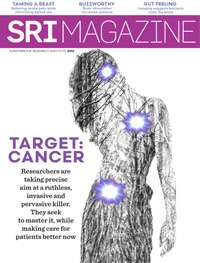Targeted therapy for lung cancer helps stem progression and is easier to tolerate

Research leads to new guidelines and moves therapy closer to being funded
June 13, 2016

Dr. Yee Ung led the creation of new guidelines for targeted therapies in lung cancer.
Cancer care is changing.
Technological advances have made it easier, faster and cheaper to draw the genetic profile of tumours, transforming the way cancers are diagnosed, classified and treated. The favoured therapies of yesteryears—blunt treatments killing healthy and diseased cells alike—are being pushed aside by a new type of care: precision medicine.
Precision medicine challenges the one-size-fits-all approach to treating disease. Instead, it advocates for therapies tailored to each patient, taking into account her genes, environment and lifestyle. One area in which precision medicine has had meaningful impact is lung cancer, the leading cause of death from cancer in Canada and worldwide.
The last 10 years has seen significant changes in treatments for lung cancer, particularly for non-small cell lung cancer (NSCLC). In the past, patients with advanced, stage four NSCLC had two options: chemotherapy, which has limited effectiveness and serious adverse effects, or palliative care. “If [patients] are stage four, unfortunately, we don’t have a cure,” says Dr. Yee Ung, a radiation oncologist at Sunnybrook’s Odette Cancer Centre. “However, there are newer therapies depending on whether they have different molecular markers.”
These molecular markers are small changes in a patient’s DNA that point to the underlying cause of her cancer. In 10% to 35% of patients with NSCLC, small typos are found in the epidermal growth factor receptor (EGFR) gene. These receptors sit on the cell surface where they transmit signals to the cell that tell it to grow and divide. The EGFR mutations seen in patients with NSCLC often render the receptors overactive, leading to uncontrolled cell growth and, ultimately, cancer.
The discovery of EGFR as a driver of disease led to the development of a new class of drugs that target the receptor and block its activity. These EGFR inhibitors have mainly been deployed in advanced NSCLC, where they have proven more effective and less toxic than chemotherapy.
Together with colleagues in the program in evidence-based care at Cancer Care Ontario (CCO), Ung published a review of 96 clinical trials to determine whether EGFR inhibitors are more suitable for some patients versus others. He found that in patients with an EGFR mutation, those who received an EGFR inhibitor as their initial therapy were able to stave off disease progression longer than those who received chemotherapy. Among patients whose EGFR mutation status was unknown, however, treatment with an EGFR inhibitor led to worse outcomes: their cancers progressed sooner than those treated with chemotherapy. These results underscore the growing role of molecular markers in determining the most appropriate course of treatment for a patient.
Another advantage of targeted therapies like EGFR inhibitors is reduced toxicity, which translates into fewer and less severe side effects. For patients with advanced NSCLC, that can have a dramatic impact on their life. “We still can’t cure [the cancer], but at least we can improve the prognosis and quality of life,” says Ung.
The team’s findings provided the basis for a new CCO guideline on use of EGFR inhibitors to treat NSCLC. “The value of the guideline is that it consolidates the evidence and it helps us make a stronger recommendation for funding,” he says. Funding from the government to cover the costs of these drugs will ensure these therapies are available to those that stand to benefit. With the evidence compiled and the recommendations submitted, all that’s left to do is wait.
This research was supported by the Cancer Care Ontario program in evidence-based care.


 On Target?: The promise and challenges of molecular therapies
On Target?: The promise and challenges of molecular therapies
